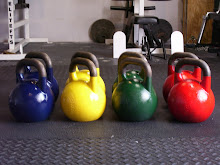Q&A Post
I've been getting a lot of questions regarding how I train my athletes via email through my website recently so I thought I'd share some of them.
Q: Hi Scott,
What have you had the most success with when training your athletes, two lower body days a week or one lower body a week? Thanks.
A: It depends on where we're at in the training cycle. I structure all my athletes programs based on the annual plan. There are different considerations for different levels. The biggest problem I have are multi-sport high school kids. One of my star high school athletes NEVER has an off season. Football in the fall crosses over with school basketball in the winter which crosses over with AAU basket ball in the spring which crosses over with football pre-season camp at the end of summer. For athletes like this we work heavy legs once a week. Usually I go heavy one week (i.e. work them up to a heavy set of 3 or 5 reps in a squat or squat variation - for example front squat, low box squat, etc.) the next week we usually work 8-10 sets of 2 reps with approx. 60% of their 1RM in a parallel box squat with either chains or bands attached to the bar. The next week we're back to a heavy 5 or 3, etc. After the main lift we usually hit a 1-legged squat (i.e. Bulgarian split squat, step up or 1-leg box squat), then a posterior chain lift (we like romanian deadlifts, glute/ham raises, 45 degree back raises, good mornings and kettlebell swings and snatches), then we'll hit abs, neck and grip. If the athlete has a TRUE off season (for instance a college football player or a high school football player who plays no other sports) we will usually train legs twice. One day is the max effort day (i.e. work up in a squat or deadlift variation to a heavy 3 or 5 rep max). The other day is the dynamic effort day (i.e. hit 8-10 doubles off a parallel box with 50-60% of the 1 rep max with chains or bands on the bar). We always follow with a 1-leg squat variation, posterior chain lift, then abs, neck and grip. When we work jumps and various plyos we do them on the dynamic day and ONLY if it is an athlete with an offseason. Athletes who are in-season year round are jumping enough.
Q: Do you find the dynamic effort being as beneficial for a pre-college athlete who needs to put on as much mass as possible?
A: Yes, athletes need to be explosive - once I have an athlete that can squat around 1.5x his bodyweight we begin dynamic work. However, for a youngster or someone brand new to strength training we do a LOT of BW squat variations and BW box squats with a broom stick to groove perfect technique. While we are doing this we are also doing slow negatives and altitude landings to teach the athlete to absorb force, VERY important for the later dynamic work and plyometrics and shock method training. We find that on the max effort day working multiple sets of heavy 5's is quite beneficial for gaining mass AS WELL AS strength, 5x5 with an appreciable load gives you the best of both worlds brother, provided the athlete is getting the appropriate calories in his system.
Q: Do you do any foam rolling, dynamic warm up, or Olympic Lifts?
A: Foam rolling - yes, I am a big believer in rehab/prehab methods, our favorites are: foam rolling, ART (I send people to Dr. Dave Radaszewski at the Soft Tissue & Chiropractic Center here in Atlanta), massage, contrast showers, ice, heat, some static flexibility work, contract relax stretching, etc.
Dynamic warm-ups - YES - HUGELY important, we use a variation of the Parisi School Warm-Up Method (Martin Rooney's stuff is incredible- www.parisischool.com).
Olympic Lifting - I don't do a lot of Oly-lifting or variations. Sometimes I don't have a lot of time to spend with a kid so we go for more bang for your buck exercises, I can teach a kid to box squat in 5 minutes but teaching a kid to clean properly takes longer. If I have a kid for a while and I know his coach is going to make him clean I will make sure he knows the lift well. I like kettlebell variations as in the swings, cleans and snatches the weight swings back behind the midline of the body and your limbs move more in a pattern that replicates a jump allowing you to display force through a greater range of motion, plus the kettlebells teach you to absorb, store and redirect a force - similar (but not the same) to the effect of plyometrics without the shock/impact - GREAT for athletes in season.
Q: Do you think athletes that are in high school, which are not as efficient with their CNS (central nervous system) are affected as much by not having an off season?
A: I feel everyone needs an offseason and if we trained our athletes properly they would be specializing in one sport by the time they are in high school. The early developmental years (up through 9 or 10 years of age) are the time for general skill development - kids should be playing a multitude of different sports and exposing their bodies/organisms to a variety of motor skill development activities. By 9 or 10 dominant traits should begin emerging (i.e. is the child showing traits of power, strength, speed, endurance, etc.) then optimally the child would be exposed to a few different sports in the vein of their dominant skill with the goal of specilization by high school age. I feel this would reduce the number of sport-related injuries, allow the athlete to peak later in their career, and increase the length of the athlete's career, not to mention contribute to optimal levels of preparedness and performance in the athlete's chosen sport.
Thanks for the questions!
Thursday, January 11, 2007
Subscribe to:
Post Comments (Atom)













No comments:
Post a Comment